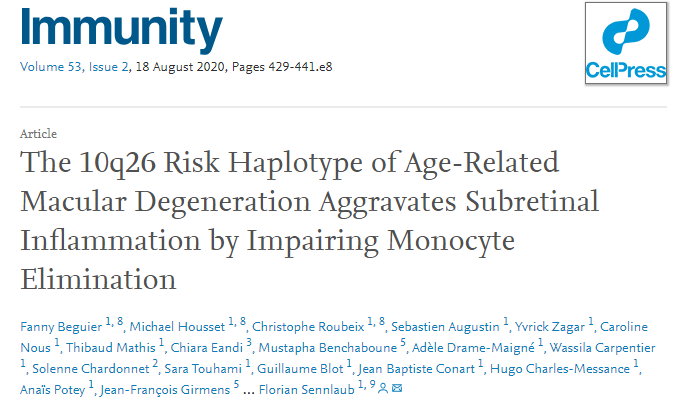The team of Professor Florian Sennlaub from Sorbonne Université recently reported a mechanistic understanding of how a minor haplotype of 10q26 locus conveys the strongest genetic risk for age-related macular degeneration (AMD), indicating that CD47 agonists and OPN inhibitors can be a potential treatment of AMD.
Congratulations to researchers for publishing the latest articles in the top-level journal "Immunity". It is a great honor for Elabscience's products to contribute to this great scientific research achievement. Elabscience is determined to be strict with itself and be the most loyal partner of scientific research scholars!
Fundamental Information
Title: The 10q26 Risk Haplotype of Age-Related Macular Degeneration Aggravates Subretinal Inflammation by Impairing Monocyte Elimination
Journal: Immunity
IF:22.553(2019)
Institution of the first author: Sorbonne Université, France
Institution of the corresponding author: Sorbonne Université, France
Elabscience® Products Cited:
|
ELISA |
Human |
Cell culture medium |


SUMMARY
A minor haplotype of the 10q26 locus conveys the strongest genetic risk for age-related macular degeneration (AMD). Here, we examined the mechanisms underlying this susceptibility.
We found that monocytes from homozygous carriers of the 10q26 AMD-risk haplotype expressed high amounts of the serine peptidase HTRA1, and HTRA1 located to mononuclear phagocytes (MPs) in eyes of non-carriers with AMD.
HTRA1 induced the persistence of monocytes in the subretinal space and exacerbated pathogenic inflammation by hydrolyzing thrombospondin 1 (TSP1), which separated the two CD47-binding sites within TSP1 that are necessary for efficient CD47 activation. This HTRA1-induced inhibition of CD47 signaling induced the expression of pro-inflammatory osteopontin (OPN). OPN expression increased in early monocyte-derived macrophages in 10q26 risk carriers. In models of subretinal inflammation and AMD, OPN deletion or pharmacological inhibition reversed HTRA1-induced pathogenic MP persistence.
Our findings argue for the therapeutic potential of CD47 agonists and OPN inhibitors for the treatment of AMD.
Highlights
1. 10q26 AMD-risk haplotype carrying monocytes overexpress HTRA1 and OPN.
2. HTRA1 locates to mononuclear phagocytes in eyes of patients with AMD.
3. HTRA1 proteolysis of TSP-1 curbs CD47-dependent OPN repression.
4. HTRA1 induced OPN promotes pathogenic subretinal MP accumulation.
5. The researchers indicated that CD47 agonists and OPN inhibitors can be a potential treatment of AMD.



